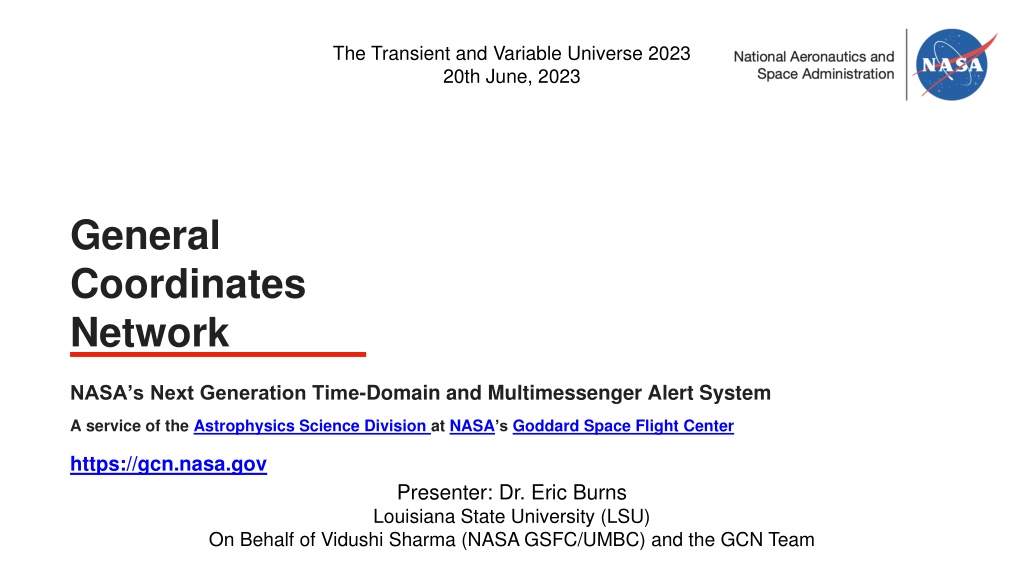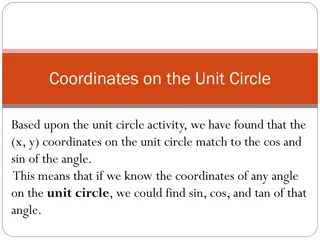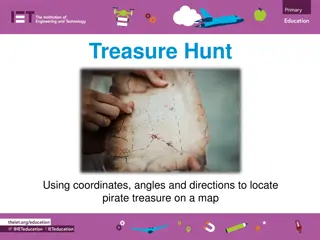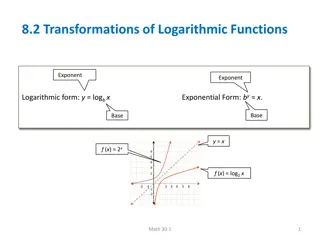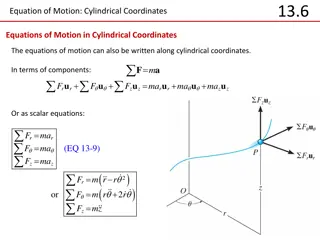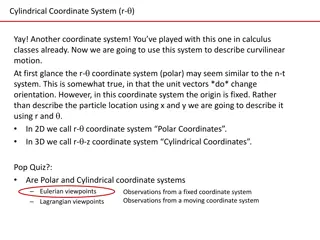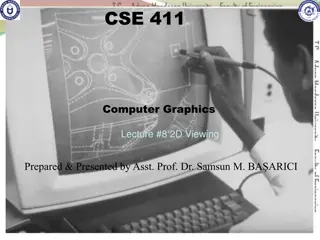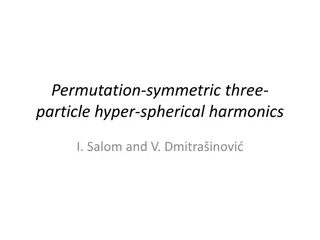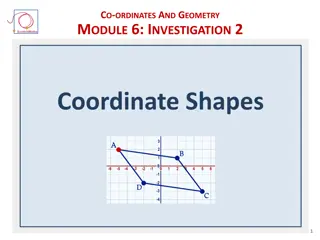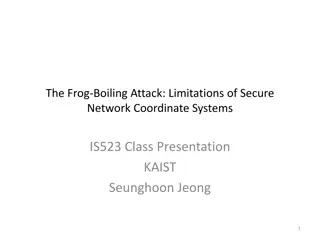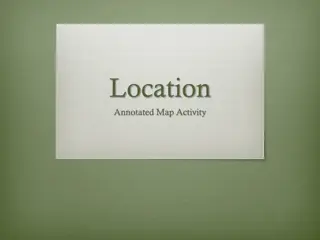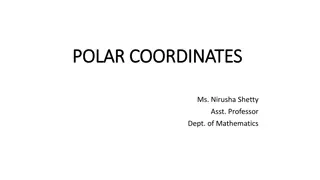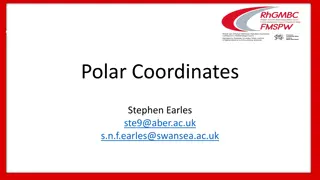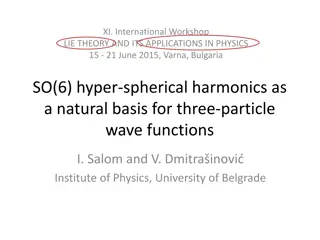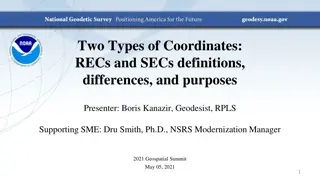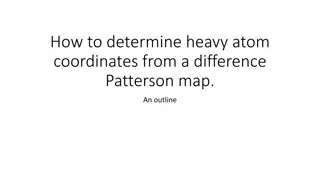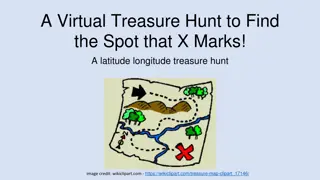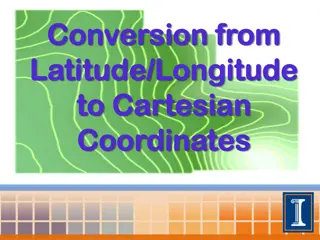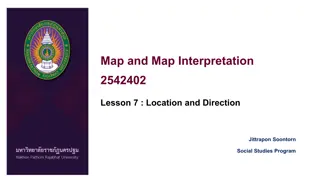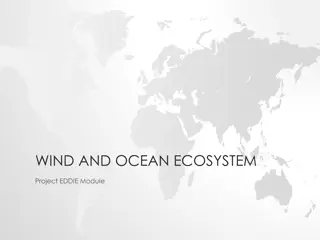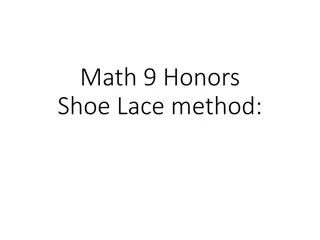General Coordinates Network
Delve into the realm of transient astrophysical events with NASA's General Coordinates Network (GCN). Dr. Eric Burns from LSU, along with the GCN team, facilitates real-time alerts and groundbreaking discoveries in astrophysics. Witness the evolution of GCN to serve new transients, messengers, and observatories, unveiling the mysteries of gamma-ray bursts, gravitational wave events, high-energy neutrinos, and more.
Download Presentation

Please find below an Image/Link to download the presentation.
The content on the website is provided AS IS for your information and personal use only. It may not be sold, licensed, or shared on other websites without obtaining consent from the author. Download presentation by click this link. If you encounter any issues during the download, it is possible that the publisher has removed the file from their server.
E N D
Presentation Transcript
The Transient and Variable Universe 2023 20th June, 2023 General Coordinates Network NASA s Next Generation Time-Domain and Multimessenger Alert System A service of the Astrophysics Science Division at NASA s Goddard Space Flight Center https://gcn.nasa.gov Presenter: Dr. Eric Burns Louisiana State University (LSU) On Behalf of Vidushi Sharma (NASA GSFC/UMBC) and the GCN Team
Gamma-ray Coordinates Network
Realtime Alerts Born of Necessity The Compton Gamma- Ray Observatory s onboard recorder failed in 1992 The need to downlink events as they occurred created an opportunity for realtime follow-up BAtse COordinates DIstribution NEtwork (BACODINE) was built to receive and distribute those alerts worldwide
Early History of GCN BACODINE provided new alert formats (phone, email, socket, and pager) New instruments and transient types led to the Gamma-ray Coordinates Network
GCN Enabled Seminal Breakthroughs in Astrophysics The GCN community enabled worldwide follow-up observations that revealed the nature of gamma- ray bursts: Afterglows and redshifts confirmed their distant, extragalactic origin Supernova-GRBs established massive stellar deaths as the cause of long GRBs Afterglow and host studies established neutron star mergers as the cause of short GRBs
There are two kinds of GCN data products: By and for machines Fixed, predefined format Schema specific to each notice type By and for humans (some automated) Freeform text (with established style) Citable (but not peer-reviewed)
The Changing Scientific Landscape GCN is constantly evolving to serve new transients, messengers, and observatories: Gravitational wave events (GW150914, GW170817) High-energy neutrinos (IC170922A) MeV neutrinos (waiting since 1987) Tidal disruption events (Swift J1644+57) Magnetar giant flares (200415A)
The Changing Technological Landscape Internet standards have led to new, better ways to serialize astronomy data (VOEvent, JSON, Avro, etc.) Encryption is necessary on the modern Internet (e.g. https) Industry has developed general time- series databases and streaming frameworks The Vera C. Rubin Observatory will use Apache Kafka to distribute transient alerts as its primary data product Many other experiments are following suit: Zwicky Transient Facility, LIGO/Virgo/KAGRA
Introducing the new GCN
The New GCN is built on Kafka GCN Classic provides three formats over three custom protocols GCN Classic over Kafka provides all three formats over one standard protocol: Apache Kafka
New GCN web site at https://gcn.nasa.gov Updated look and feel More accessible, based on US Web Design System Single sign on with: email and password Google Facebook LaunchPad (for NASA employees and affiliates)
The New GCN Circulars
Improvements to Circulars The new GCN Circulars are: Self service: Manage your own subscriptions and settings. More inclusive: It's easy to join the community and submit a GCN Circular. Fast: Email notifications are distributed in parallel to all users within seconds. Robust: Circulars run on highly available, distributed cloud services. Sustainable: GCN Circulars are robustly funded by NASA and are part of the open source GCN project
Tutorial on Receiving and Submitting GCN Circulars Launch quick start Go to https://gcn.nasa.gov and See Presentation: https://nasa- gcn.github.io/gcn-presentation/
Whats next for GCN?
Coming soon to GCN Circulars We're planning lots of enhancements soon to make GCN Circulars even better: Receive Circulars over Kafka Real-time integration with SAO/NASA Astrophysics Data Service (ADS) Link multiple emails with your account Link your ORCID to your account DOIs and BiBTeX entries for all Circulars Browse Circulars by event Embed tables, coordinates, images, and styled text in Circulars with Astro Flavored Markdown
More enhancements are coming to GCN: New alert types and alerts from new missions and facilities Unified schema and alert format for GCN Kafka Integrated, searchable database of Notices and Circulars (GCN Viewer) Interoperability with other transient Kafka brokers (e.g. SCiMMA)
Create new Notice types All new notice topics will only be distributed by GCN Kafka See step-by-step instructions Preferred notice format is JSON Unified JSON schema in development: IceCube, GlowBug, Swift/Guano are our first producers
Unified schema and alert format for GCN Kafka JSON schema with common core fields Instrument/mission/observatory specific fields where needed https://github.com/nasa-gcn/gcn-schema Schema Browser and Schema design documentation coming soon JSON example of IceCube schema:
Thanks for listening! Web site: https://gcn.nasa.gov This presentation: https://nasa-gcn.github.io/gcn-presentation/
Schema Browser (In Development) A step in the process for setting up New Notice Producers. Browse the schema definitions for notices distributed by GCN Kafka
Schema Design (In Development) Steps for designing the mission specific schema IceCube, Glowbug, Swift/Guano have already joined the suit
